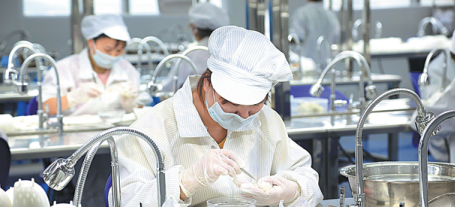Cooperation boosts region's prosperity

In the context of the long-standing Sino-Malaysian friendship, the Guangxi Zhuang autonomous region has given full play to its unique geographical advantages to promote practical cooperation with Malaysia through the advancement of its industrial parks.
China-Malaysia Qinzhou Industrial Park is the flagship project of investment cooperation between China and Malaysia.
Adjacent to the Qinzhou Free Trade Port Area, the park covers 55 square kilometers, with a planned population of 500,000. It is planned to be divided into functional areas such as an industrial area, residential area, technology research and development area, and supporting service area. The park has been constructed in three phases, and the first phase is 15 sq km, of which the startup area is 7.87 sq km.
By the end of 2021, the park has achieved a total regional GDP of 17.17 billion yuan ($2.7 billion), with an average annual compound growth rate of 33.35 percent. It recorded a total industrial output value of 39.17 billion yuan, with an average annual compound growth rate of 27.98 percent. Since its establishment, more than 200 projects have been signed and settled, with a total investment of over 190 billion yuan.
Wang Xiongchang, mayor of Qinzhou, said the industrial park aims to establish a joint investment attraction mechanism and focus on attracting projects in biomedicine, electronic information, equipment manufacturing, new energy, new materials and ASEAN's traditional industries.
Lim Ban Hong Malaysia's deputy minister of international trade and industry, said that the China-Malaysia park is a major government-to-government cooperation project directly initiated and promoted by the leaders of China and Malaysia.
Yang Bin, executive deputy director of the management committee at Qinzhou Free Trade Port Area, said in the next 10 years, China and Malaysia will establish a closer coordination mechanism for the development of "two countries and two parks" model.
"We will explore and innovate such sectors as science and technology, education, talents and cultural exchanges."
Malaysia is Guangxi's third-largest trading partner in ASEAN. In 2021, the trade volume between the two sides was $1.9 billion, an increase of 53.5 percent. Products such as Malaysian durian are very popular among Guangxi people. Malaysia is also the largest investment destination for Guangxi enterprises in ASEAN, with a two-way investment of $2.5 billion in 2021.
The infrastructure construction of China-Malaysia Qinzhou Industrial Park has been accelerated in an all-around way. At present, the first phase of 15 sq km of "seven connections, one level and one green" and other infrastructure have been completed.
The land acquisition area of 24 sq km has been completed and the comprehensive improvement of the Jingu River area is being accelerated.
Relying on Malaysia's rich mollusk resources, the park promotes the construction of the Malaysian mollusk pretreatment center, guides domestic enterprises to participate in shareholding, and arranges the molasses procurement and pretreatment links in Malaysia. It has built a processing trade base for edible bird's nest in China-Malaysia Qinzhou Industrial Park. At present, there are three preprocessing centers in Malaysia that have been registered overseas by the General Administration of Customs of China. The trade base for edible bird's nest in the park has had 15 bird's nest production and processing enterprises settle in, 11 of which have been approved by the General Administration of Customs for wool swallow processing qualifications.
Qinzhou Port continues to optimize facilities and comprehensive shipping service capacity building. In 2021, it started the construction of the country's first sea-rail combined transportation automated terminal and built a 200,000-tonnage one-way channel and a 300,000-tonnage oil terminal that can meet the entry and exit requirements of the world's largest container ships. In 2021, various commodities worth 622 million yuan were exported to Malaysia through Qinzhou Port.

Workers check cubilose at a production line on China-Malaysia Qinzhou Industrial Park. CHINA DAILY
MOST POPULAR
- 1 $39.7 billion worth of deals inked at Airshow China
- 2 China announces tax relief measures to stabilize real estate sector
- 3 A look at China's economy in October, 2024
- 4 Public holiday extension announced
- 5 China's NEV annual production hits 10 million milestone amid global carbon reduction efforts
Editors' Picks
 Infographic:
Golden jubilee of China-Brazil relations
Infographic:
Golden jubilee of China-Brazil relations
 Infographic:
A look at China's economy in October 2024
Infographic:
A look at China's economy in October 2024





